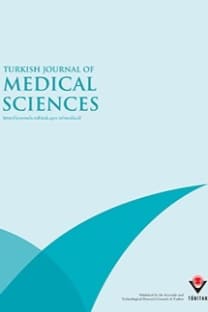Differences in the effectiveness of serum biomarkers for the diagnosis of bacterial infections in adult and elderly patients admitted to the emergency department
Bacterial infections, emergency department, serum biomarkers, adults, geriatrics
Differences in the effectiveness of serum biomarkers for the diagnosis of bacterial infections in adult and elderly patients admitted to the emergency department
Bacterial infections, emergency department, serum biomarkers, adults, geriatrics,
___
- Hosoglu S, Parlak Z, Geyik MF, Palanci Y. Critical evaluation of antimicrobial use--a Turkish university hospital example. J Infect Dev Ctries 2013; 7: 873–879. 4. Angus DC, Randy SW. Epidemiology of sepsis; an update. Crit Care Med 2001; 9: 109–116.
- Hicks CW, Engineer RS, Benoit JL, Dasarathy S, Christenson RH, Peacock WF. Procalcitonin as a biomarker for early sepsis in the emergency department. Eur J Emerg Med 2014; 21: 112– 117.
- Limper M, Kruif MD, Duits AJ, Brandjes DP, van Gorp EC. The diagnostic role of procalcitonin and other biomarkers in discriminating infections from non-infectious fever. J Infect 2010; 60: 409–416. 9. Maruna P, Nedelníková K, Gürlich R. Physiology and genetics of procalcitonin. Physiol Res 2000; 49: 57–61.
- Uusitalo-Seppala R, Koskinen P, Leino A, Peuravuori H, Vahlberg T, Rintala EM. Early detection of severe sepsis in the emergency room: diagnostic value of plasma C-reactive protein, procalcitonin, and interleukin-6. Scand J Infect Dis 2011; 43: 883–890.
- Magrini L, Travaglino F, Marino R, Ferri E, De Berardinis B, Cardelli P, Salerno G, Di Somma S. Procalcitonin variations after Emergency Department admission are highly predictive of hospital mortality in patients with acute infectious diseases. Eur Rev Med Pharmacol Sci 2013; 17: 133–142.
- Shen CJ, Wu MS, Lin KH, Lin WL, Chen HC, Wu JY, Lee MC, Lee CC. The use of procalcitonin in the diagnosis of bone and joint infection: a systemic review and meta-analysis. Eur J Clin Microbiol Infect Dis 2013; 32: 807–814.
- Jaimes FA, De La Rosa GD, Valencia ML, Arango CM, Gomez CI, Garcia A, Ospina S, Osorno SC, Henao AI. A latent class approach for sepsis diagnosis supports use of procalcitonin in the emergency room for diagnosis of severe sepsis. BMC Anesthesiol 2013; 13: 23.
- Bone RC, Balk RA, Cerra FB, Dellinger RP, Fein AM, Knaus WA, Schein RM, Sibbald WJ. Definitions for sepsis and organ failure and guidelines for the use of innovative therapies in sepsis. The ACCP/SCCM Consensus Conference Committee. American College of Chest Physicians/Society of Critical Care Medicine. Chest 1992; 101: 1644–1655.
- Cavaillon JM, Adib-Conquy M, Fitting C, Adrie C, Payen D. Cytokine cascade in sepsis. Scand J Infect Dis 2003; 35: 535– 544.
- Hotchkiss RS, Karl IE. The pathophysiology and treatment of sepsis. N Engl J Med 2003; 348: 138–150.
- Russell JA. Management of sepsis. N Engl J Med 2006; 355: 1699–1713.
- Gavazzi G, Krause KH. Ageing and infection. Lancet Infect Dis 2002; 2: 659–666.
- Lai CC, Chen SY, Wang CY, Wang JY, Su CP, Liao CH, Tan CK, Huang YT, Lin HI, Hsueh PR. Diagnostic value of procalcitonin for bacterial infection in elderly patients in the emergency department. J Am Geriatr Soc 2010; 58: 518–522.
- Heppner HJ, Bertsch T, Alber B, Esslinger AS, Dragonas C, Bauer JM, Sieber CC, Steichen O, Bouvard E, Grateau G et al. Diagnostic value of procalcitonin in acutely hospitalized elderly patients. Eur J Clin Microbiol Infect Dis 2009; 28: 1471– 1476.
- Mondal SK, Nag DR, Bandyopadhyay R, Chakraborty D, Sinha SK. Neonatal sepsis: role of a battery of immunohematological tests in early diagnosis. Int J Appl Basic Med Res 2012; 2: 43– 47.
- Kaur K, Mahajan R, Tanwar A. A novel marker procalcitonin may help stem the antibiotic overuse in emergency setting. Int J Appl Basic Med Res 2013; 3: 77–83.
- Hoeboer SH, Groeneveld AB. Changes in circulating procalcitonin versus C-reactive protein in predicting evolution of infectious disease in febrile, critically ill patients. PLoS One 2013; 8: e65564.
- Cornelissen CG, Frechen DA, Schreiner K, Marx N, Krüger S. Inflammatory parameters and prediction of prognosis in infective endocarditis. BMC Infect Dis 2013; 13: 272.
- Ha YE, Kang CI, Wi YM, Chung DR, Kang ES, Lee NY, Song JH, Peck KR. Diagnostic usefulness of procalcitonin as a marker of bacteremia in patients with acute pyelonephritis. Scand J Clin Lab Invest 2013; 73: 444–448.
- ISSN: 1300-0144
- Yayın Aralığı: 6
- Yayıncı: TÜBİTAK
Relationship among MIF, MCP-1, viral loads, and HBs Ag levelsin chronic hepatitis B patients
HAYATİ GÜNEŞ, RAFET METE, MURAT AYDIN, BİROL TOPÇU, MUSTAFA ORAN, MUSTAFA DOĞAN, OĞUZHAN YILDIRIM, İLKNUR ERDEM, AYNUR EREN TOPKAYA, AHMET GÜREL
HACI AHMET BİRCAN, MÜNİRE ÇAKIR, İLKAY YILMAZER KAPULU, RECEP SÜTCÜ, SELÇUK KAYA, ÖNDER ÖZTÜRK
HAVA YILMAZ, LATİF DURAN, KERAMETTİN YANIK, MEHMET ALTUNTAŞ, MUSTAFA SÜNBÜL
RAMAZAN GÜMRAL, AYLİN DÖĞEN, MEHMET MACİT İLKİT
Serologic testing for celiac disease in young people with elevated transaminases
Juanli YUAN, Jinyan GAO, Yonghong YAO, Hongbing CHEN
SURAPANENI KRISHNA MOHAN, VISHNU PRIYA VEERARAGHAVAN, MALLIKA JAINU
Leyla BAHAR, Semra KAHRAMAN, Nazan ERAS, Caroline PIRKEVI
Short-term effect of transcatheter aortic valve implantation on QT dispersion
HACI AHMET KASAPKARA, HÜSEYİN AYHAN, TAHİR DURMAZ, TELAT KELEŞ, CENK SARI, SERDAL BAŞTUĞ, CEMAL KÖSEOĞLU, BİLGE DURAN KARADUMAN, MURAT AKÇAY, NİHAL AKAR BAYRAM, EMİNE BİLEN, ENGİN BOZKURT
Characterization of HCV genotype 4d infections in Kayseri, Turkey
Gül ERGÖR, Tuba KAYMAN, Ceylan POLAT, Yusuf Hakan ABACIOĞLU
Lale OLCAY, Deniz BİLLUR, Esra ERDEMLİ, Sidika Esra BASKIN, Havva Fatma BALCI, Sevgi YETGİN
